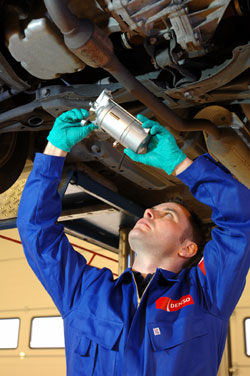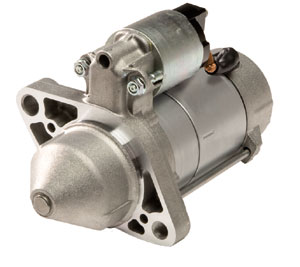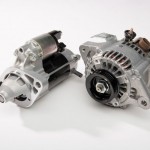Starters and Alternators have a vital role to play – from starting the motor to keeping the vehicle running – no vehicle is complete without them.
Nick Thomas, Product Manager at DENSO Aftermarket Sales UK & Ireland explains how the company’s Starters and Alternators have evolved to bring cutting-edge, world class rotating machine technology to the aftermarket.
The first this two-part series looks at the history of starter motors.
Since the evolution of more ‘intelligent’ vehicles featuring equipment such as navigation systems and complex electronic control panels, the demands placed on the starter and alternator have increased dramatically. The continual need for higher power outputs – without compromising weight limitations and improved environmental standards – has led DENSO to develop rotating machines that are smaller, lighter, quieter and more powerful.
More recently the growth of stop-start technology in Europe has been more rapid than anywhere else in the world. Driven by strict European regulations (95g/km by 2020), European car manufacturers are looking to develop vehicles which improve fuel efficiency and reduce CO2 emissions.
Stop-Start systems, which automatically stop the engine while the vehicle is waiting at traffic lights, or is stopped for other reasons, and restart it smoothly when the vehicle needs to move again, hold part of the solution. The technology, which centres on the vehicle’s starter, has proved to be reliable and cheap to manufacture, saving drivers gallons of fuel every year and reducing the level of harmful emissions produced by cars every year.
Advanced Starters from DENSO – then and now
DENSO launched its first OE Starter programme in the early 1960s. From there the products’ design and efficiency have developed in line with the demands of modern vehicles, including the introduction of External-Gear Deceleration R and RA-Starters in the early 1970s and late 1980s respectively.
 However, it was in the early part of the 21st century that saw the ‘big leap’ in starter technology, with DENSO’s introduction of the world’s first PS Starter (Planetary Reduction Segment Conductor Motor). Featuring a square conductor in the armature coil, the PS starter was 22% lighter and 14% shorter than its predecessor, resulting in improved fuel efficiency and mountability.
However, it was in the early part of the 21st century that saw the ‘big leap’ in starter technology, with DENSO’s introduction of the world’s first PS Starter (Planetary Reduction Segment Conductor Motor). Featuring a square conductor in the armature coil, the PS starter was 22% lighter and 14% shorter than its predecessor, resulting in improved fuel efficiency and mountability.
Most recently DENSO’s newest additions to this market include the Advanced Engagement (AE) Starter – DENSO’s first stop-start starter – and the Tandem Solenoid incorporating the latest DENSO technology.
Designed specifically for stop-start systems using the world’s first mechanism to separately control the forward shift of the pinion gear and the motor rotation, DENSO’s innovative Tandem Solenoid (TS) Starter ensures a quick restart even when the engine is rotating. Depending on vehicle specifications, the technology can help improve fuel efficiency by approximately 3 to 5%.
The Advanced Engagement (AE) Starter works like a typical planetary starter but has 10 times the durability. When it’s energised, the pinion shifts forward, engages with the flywheel, and immediately spins. In terms of starter motor-based solutions for stop-start systems, AE starter is the easiest to integrate to the engine, requiring no unique controls or engine modifications. It helps car manufacturers achieve approximately 3-5% fuel savings, depending on engine size.
DENSO Starters development history
1960s – F-starter
- Unique structure with the pinion gear pushed through the drive lever
- Spiral brush spring
- Aluminium end frame
1970s – External-Gear Deceleration R-Starter
- World’s first deceleration structure – decreased the mass by half, while maintaining the same output
- Pinion direct-shift method improves environmental durability
1980s – External-Gear Deceleration RA-Starter
- High-speed motor with an improved deceleration ratio and heat-resistant electric wire reduces the size and weight of the motor
- Cold-forged spline reduces the size and weight of the magnetic switch
2000s – Internal-Gear Deceleration PS-Starter
- A rectangular conductor and surface commutator in the armature and a magnet between the main electrodes of the yoke, reduced the size and weight of the starter
- Combining the damper unit and the high deceleration ratio reduced the size and lowered driving noise
 Stop/Start Starters
Stop/Start Starters
- Long life starter technology, quick and quiet restart times
- Advanced Engagement (AE) StarterThe AE includes key design features like dual layer, long-life electrical brushes, as well as a unique pinion spring mechanism that reduces ring gear/ flywheel wear by approximately 90%
- Permanently Engaged (PE) StarterJointly developed with a leading car manufacturer
The PE Starter delivers the quickest and quietest restart times of all starter motor-based systems, with increased overall fuel-saving potential. Starter and flywheel gears are permanently connected, meaning there are no difficulties with the dynamics of gear engagement and disengagement.
- Tandem Solenoid (TS) StarterThe TS starter is unique, because it restarts the car’s engine before zero rpm. It is the first starter in the world to use a structure that separately controls starting the motor and shifting the pinion gear and it can fit in the same space as a traditional starter.










